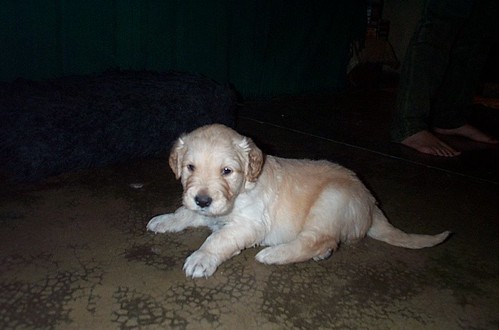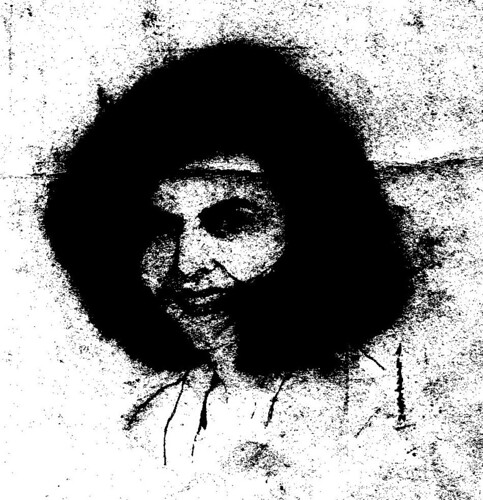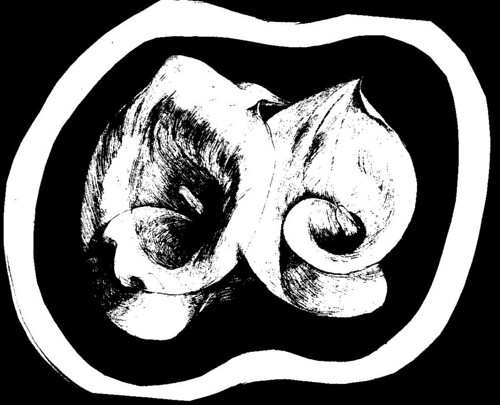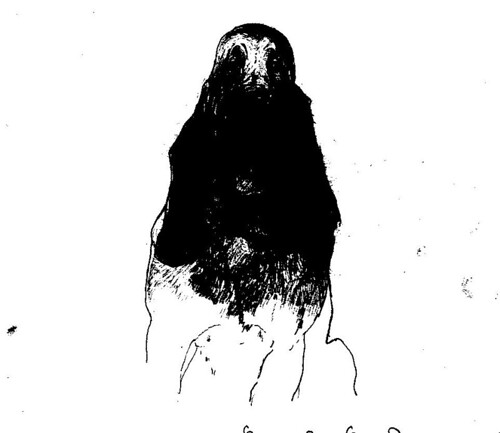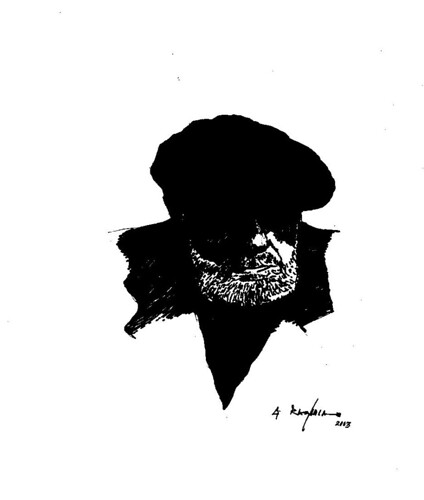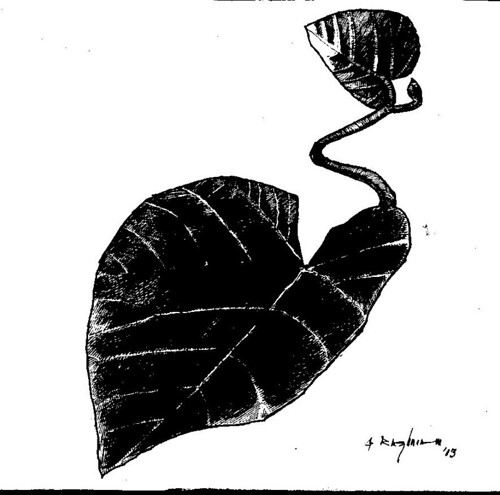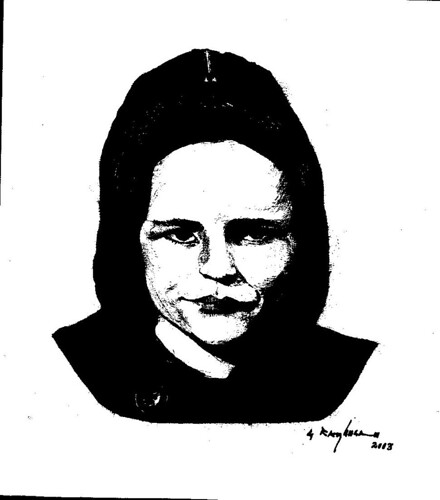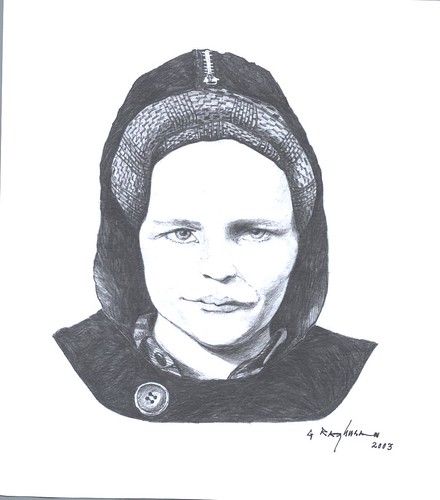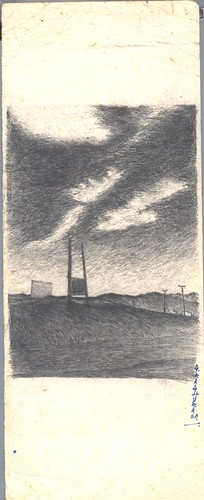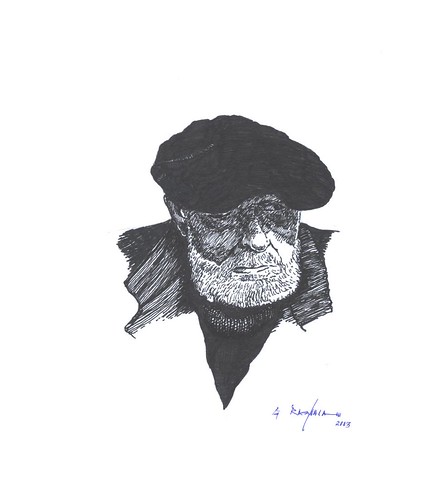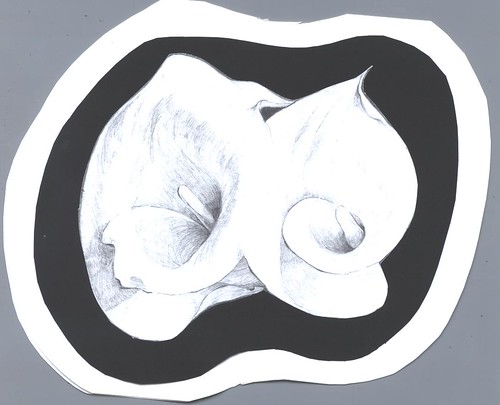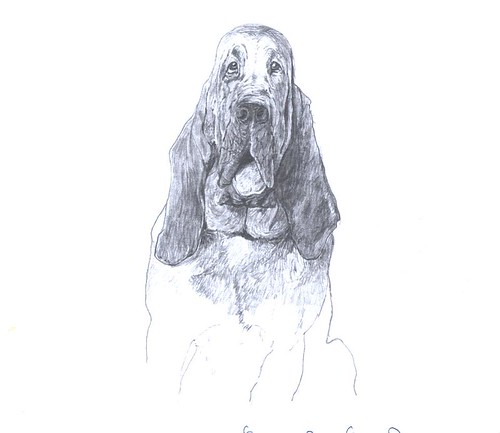Thursday, May 31, 2007
M
M Theory? Maybe because you get five different views of the same object from such an arrangment of mirrors, one less.
~ Born in an idyllic moment captured while watching Brian Greene's The Elegant Universe
Tuesday, May 29, 2007
Monday, May 28, 2007
... must be drawn for the law-abiding against the law-fearing.
Saturday, May 26, 2007
Does provision for libel constitute a fundamentalist restriction on the freedom to criticise?
Exercise Continues : Defence Through Offence
Internationa Herald Tribune : Editorials & Commentary : Opinion : Meanwhile : The Right To Be Offended : Salil Tripathi
And so we set up Mr Hussain as an undoubtably agreeable aggrieved. I am not too sure about the range of creativity, though this be an impression one keeps to oneself.
One can imagine how such speeches are written and delivered. And, this is an unnecessary aside, unless of course you desire to set up a halo around the artist. What is this about the need for "international" recognition? Wait a moment, we are not getting drawn into asides here.
The female deities in question had some or the other aspect of sexuality associated with them, going by the related mythology. I am not too sure the same applies to the notion of the Mother Nation, young as it may be. Does it have to do with the difficulty in imagining your mother in bed? Be it that this Nation be a myth; there seems to be a sense of convenient equivalence here, not entirely justified and somewhat dissonant.
"Not only through the elegant rendering of horses," is said right after "astonishing range of creativity". Petty point. Let it not be registered. And the less said about the mood of his patrons, the better. We do not wish to disturb him from resting on his laurels. The rest are non-sequitirs with merely a tangential bearing on the matter discussed in the previous paragraph.
They may not be lewd drawings meant to titillate, but why do you gloss over the possibility that nudity in this context is associated with sex, penury or asceticism. Now which of your favourite goddesses would you prefer being portrayed in which mode? I would humbly suggest that there is nothing abstract about any of them. And how long, goiing by your study of history and intimate knowledge of human nature, would you estimate such abstractions take to percolate down to one and all? Sans dissonance? The problem with dissonance is that, once actuated, you either end up with the opposite stance ( thereby appearing rather foolish and inconsistent ) or crystallise on your taken position ( rather violently at times ). Why the surprise at the offence taken? And, I beg to submit, there is nothing abstract about "delineation of the body into sharp lines" so as to "suggest formlessness" - and if there be, as I can imagine, I can also imagine it being absolutely incomprehensible.
So we agree that it may be a tad too abstract. And that is enough for us to start using labels pejoratively. Only 1200 cases? We would have imagined it being more abstract than that.
So much for Artistic Integrity in the Face of Adversity. Neat paraphrasing. They were "pure and uncovered" - but they are not now, in the same way that our sexuality here has evolved therefrom.
We have referred to evolution of religious sentiment, reality and implied the need for assertion in the domain of information earlier. Interpretation is another matter for another day.
~ Advocatus Diaboli
Internationa Herald Tribune : Editorials & Commentary : Opinion : Meanwhile : The Right To Be Offended : Salil Tripathi
Maqbool Fida Husain is India's most renowned contemporary painter. Even at the ripe old age of 90, he remains active, holding exhibitions around the world that draw many visitors, commanding a huge premium for his canvases, and revealing an astonishing range of creativity.
And so we set up Mr Hussain as an undoubtably agreeable aggrieved. I am not too sure about the range of creativity, though this be an impression one keeps to oneself.
This month in London, Kamlesh Sharma, the Indian high commissioner, inaugurated an exhibition of his early work. Calling him India's greatest modern artist, Sharma said, "Husain's career and success mirrors closely the meteoric rise of contemporary Indian art on the international stage."
One can imagine how such speeches are written and delivered. And, this is an unnecessary aside, unless of course you desire to set up a halo around the artist. What is this about the need for "international" recognition? Wait a moment, we are not getting drawn into asides here.
And yet with all of his accomplishments, Husain faces the risk of prosecution - in India. His alleged crime? A painting of Bharat Mata, or Mother India, in the nude. This work comes on top of many paintings over the years that show several revered Hindu female deities in the nude. Hindu nationalists have run a decade-long campaign against Husain; now, quixotically, India's center-left governing coalition is supporting them. There have been ripple effects: Because of threats from Hindu nationalists, the London exhibition has been closed.
The female deities in question had some or the other aspect of sexuality associated with them, going by the related mythology. I am not too sure the same applies to the notion of the Mother Nation, young as it may be. Does it have to do with the difficulty in imagining your mother in bed? Be it that this Nation be a myth; there seems to be a sense of convenient equivalence here, not entirely justified and somewhat dissonant.
Husain has remained in the limelight, not only through his elegant rendering of horses, but also by capturing India's mood over the past six decades. He has become the artistic equivalent of a poet laureate, celebrating India's triumphs and weeping over its tragedies. All along, Husain has celebrated India's diversity, embodying its inclusive culture.
"Not only through the elegant rendering of horses," is said right after "astonishing range of creativity". Petty point. Let it not be registered. And the less said about the mood of his patrons, the better. We do not wish to disturb him from resting on his laurels. The rest are non-sequitirs with merely a tangential bearing on the matter discussed in the previous paragraph.
Indeed, Husain has painted several goddesses from the Hindu pantheon in the nude, including Saraswati, the goddess of learning, Lakshmi, the goddess of wealth, and Durga, a martial goddess who slays demons. These are bold works that reshape our thinking about Hindu myths, revealing them in new light; they are not lewd drawings meant to titillate. His nudes delineate the body in sharp lines, elevating it to an abstract realm, suggesting the formlessness of divinity.
They may not be lewd drawings meant to titillate, but why do you gloss over the possibility that nudity in this context is associated with sex, penury or asceticism. Now which of your favourite goddesses would you prefer being portrayed in which mode? I would humbly suggest that there is nothing abstract about any of them. And how long, goiing by your study of history and intimate knowledge of human nature, would you estimate such abstractions take to percolate down to one and all? Sans dissonance? The problem with dissonance is that, once actuated, you either end up with the opposite stance ( thereby appearing rather foolish and inconsistent ) or crystallise on your taken position ( rather violently at times ). Why the surprise at the offence taken? And, I beg to submit, there is nothing abstract about "delineation of the body into sharp lines" so as to "suggest formlessness" - and if there be, as I can imagine, I can also imagine it being absolutely incomprehensible.
This explanation, which is faithful to Hindu philosophy, is too abstract for fundamentalists who have protested against his works, and in some cases, ransacked art galleries in India displaying his art. Some Hindu groups have also used the courts: More than 1,200 cases have been filed against him.
So we agree that it may be a tad too abstract. And that is enough for us to start using labels pejoratively. Only 1200 cases? We would have imagined it being more abstract than that.
Husain has apologized for hurting sentiments. Explaining his motives, the painter has traced his art to India's millennia-old heritage in which gods and goddesses were "pure and uncovered."
So much for Artistic Integrity in the Face of Adversity. Neat paraphrasing. They were "pure and uncovered" - but they are not now, in the same way that our sexuality here has evolved therefrom.
But we live in complicated times. Hindu nationalists have grown more assertive since the 1990s, complaining about the inequity in taking Hindus for granted while appeasing Muslim sensibilities. Some Hindus are seething over this perceived injustice: Because of the amount of attention Muslims have commanded when they have been offended by images they consider blasphemous - a concept alien to Hinduism - Hindus want equal treatment. They want the right to be offended.
But as Husain has said, the sacred and the profane have always coexisted in India. As a faith, Hinduism is broad enough to include some sects that think sex is the way to enlightenment, and broadminded enough to overlook some ascetics roaming around naked, their bodies smeared with ash, during major religious congregations.
In some Indian literature and art, nudity connotes purity and openness, not vulgarity. Architects have decorated many temples with nude deities. Bronze sculptures of scantily clad Hindu goddesses made during the Chola period are no less divine. The temples in Khajuraho from the Chandela period have hundreds of erotic statues. Husain is linking his art with these traditions.
It is hypocritical to place curbs on Husain's artistic freedom. What's more shameful is that a government that claims to be the secular alternative to Hindu nationalists is threatening to prosecute Husain. This does not do India proud; it adds to India's disgrace.
We have referred to evolution of religious sentiment, reality and implied the need for assertion in the domain of information earlier. Interpretation is another matter for another day.
~ Advocatus Diaboli
Tuesday, May 22, 2007
Two slim volumes ... that one has been waiting for, the past three months or so. Looks like a Night Out ...
Godel's Proof : Ernest Nagel & James R Newman, edited by Douglas R Hofstadter.
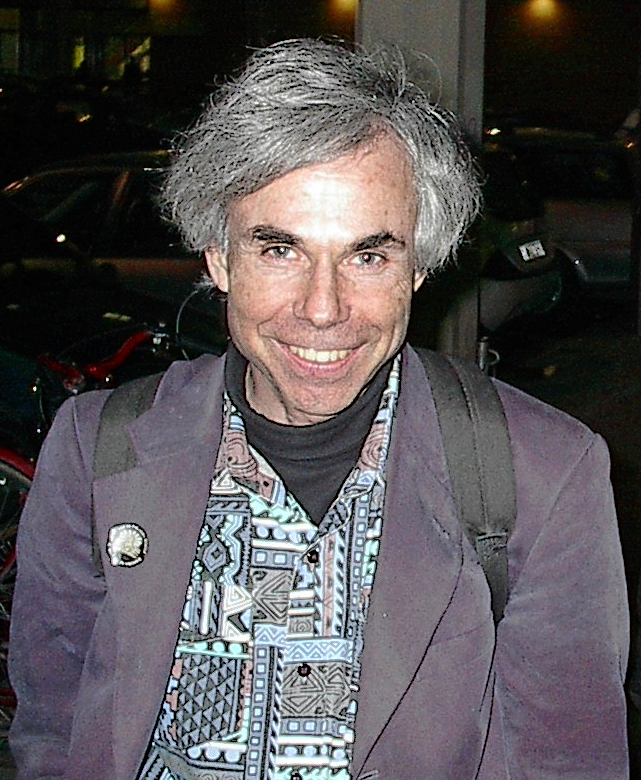
Are Quanta Real? : A Galilean Dialogue : JM Jauch, with a foreword by Douglas R Hofstadter.

Quote
It is quite impossible to stand in proper relationship to a piece of writing if you don't know in what context, or crucially when, it was written.
~ David EH Jones, in Nature, 337 (February 2 1989), p. 420.
I do not think I could agree more.
It is quite impossible to stand in proper relationship to a piece of writing if you don't know in what context, or crucially when, it was written.
~ David EH Jones, in Nature, 337 (February 2 1989), p. 420.
I do not think I could agree more.
Sunday, May 20, 2007
Were all prophets, seers and messiahs undiagnosed Paranoid Schizophrenics? All religion must stem from there ...

The Rebel
A Happy Death
The First Man
The Plague
I found The Fall and The Stranger to be subversively influential.
Friday, May 18, 2007
One looks forward atavistically. And bends over backwards too.
Did I just describe the Moebius Strip?
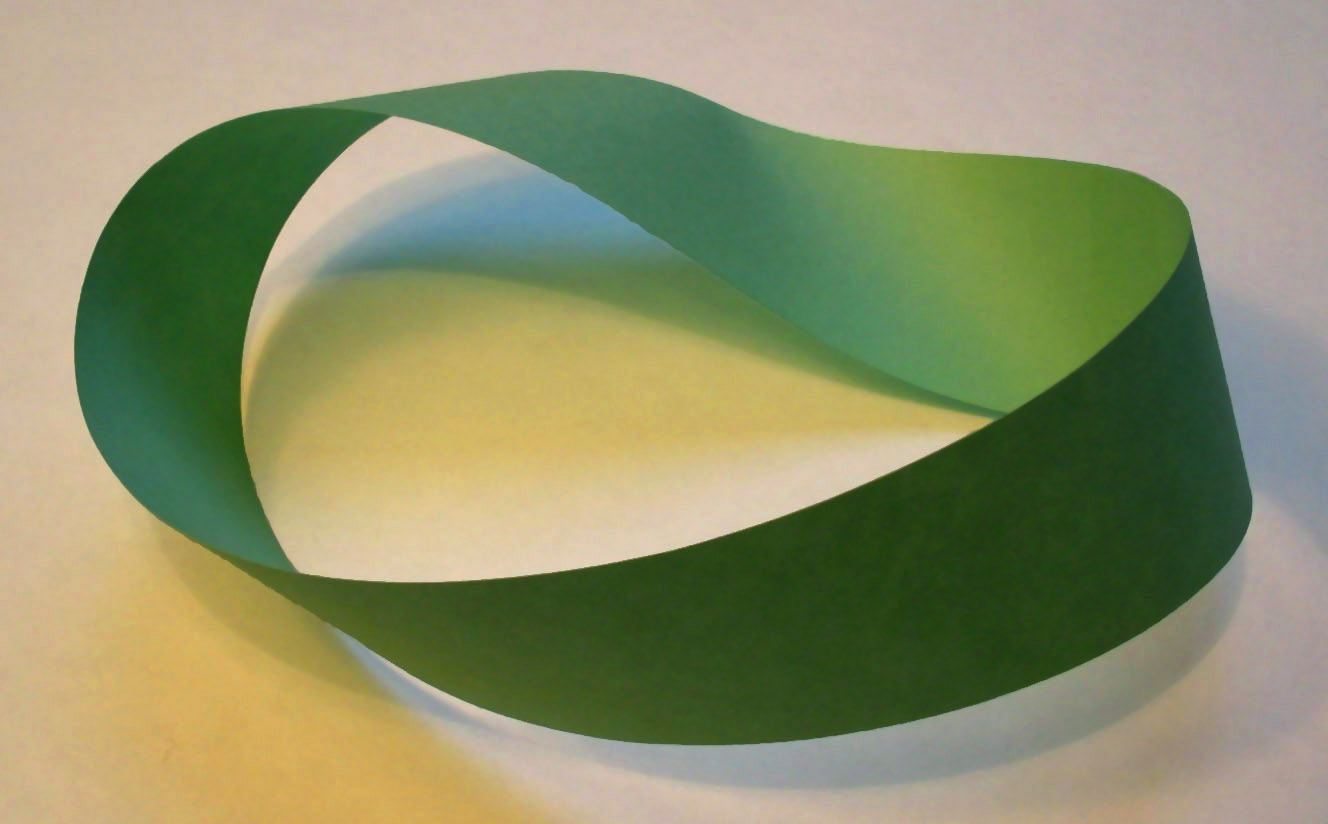
Tuesday, May 15, 2007
Do read the Original paper on the link above. Why? It might explain your responses to the past three posts on this page. As well as the reason that prompted them in the first place.
The Defence Rests
A little thought experiment might be in order. Assume that the Hindutva goons found an opportunity to gain a bit of coverage / prominence by doing what they did. Now assume that the media itself did feel that it was a minor matter and did not deserve any attention - there are far more important things clamouring for space. Would the matter have gone any farther than it did? Let such events become snippets of news ( at best ) and see if the behaviour is going to be repeated. Mr Hoskote's question above would find its answer.
What do I believe? I don't. Just curious, would do.
~ Advocatus Diaboli
What happens next? Will the champions of Hindutva go around the country destroying temple murals, breaking down monuments, and burning manuscripts and folios?Maybe? But seriously, the only question that is asked is whether Traditional Artists who paint what forms the basis of the protest have been harassed by these Hindutva goons. Have they? Other than penury enforced upon by a changing social and economic climate, have they been threatened? If not, then the question remains - why is it that they are allowed to go into natural decline and oblivion, whereas the more established, contemporary and media savvy artists are targeted? How much of it has to do with Hindu Culture and how much with the regime of Information?
A little thought experiment might be in order. Assume that the Hindutva goons found an opportunity to gain a bit of coverage / prominence by doing what they did. Now assume that the media itself did feel that it was a minor matter and did not deserve any attention - there are far more important things clamouring for space. Would the matter have gone any farther than it did? Let such events become snippets of news ( at best ) and see if the behaviour is going to be repeated. Mr Hoskote's question above would find its answer.
What do I believe? I don't. Just curious, would do.
~ Advocatus Diaboli
Exercise Continues : Defending The Indefensible
From Painting the Art World Red
Some other questions might be in order here - the Artist might have a right to revisit inherited lore ( devoid of the context in which it originally germinated ), but then he/she does not have to. What is the purpose of reinvention of that which has remained static over the years? What is that which you have arrived at, having reinvented / revisited? The rest of the sentence is drivel - what does it mean in a social / religious sense? What is the affronted man to make of it? And how? In tangible terms - How?
Indeed. Would it have worked? Would such "talking" have been taken seriously by those who were supposed to be spoken to?
What Mr Hoskote fails to realise that Subversion does not come easy. Is he so distanced from the complexities of Reality and the nature of History to percieve that it is idiotic to expect the State and the hoi polloi to make is convenient for their perceptions and beliefs to be subverted by a handful of "cultural practitioners"?
~ Advocatus Diaboli
From Painting the Art World Red
The right to take offence is not a fundamental right guaranteed by the Constitution, but all the same, it is the most easily enforced of all rights. All you need is a local demagogue with a taste for publicity, a few rampaging goons, policemen who favour the violent over the reasonable, and a lower judiciary that is reluctant to defy the mob.
True enough. If such be the case, why expect anything different? Would that not be unrealistic? And so, if it happens with increasing frequency, you have to get down to working within such constraints and reinvent your stymied imagination to flourish under such strictures. Would that not be a Litmus Test of the truly talented?
Both images insist upon the artist’s right to revisit inherited lore, to reinvent images and narratives, to integrate the sacred as an element of secular experience.
Hoskote needs to be more lucid than this. Try taking these words across to those who felt offended and make some sense to them. Explain it to them in a language that they can understand ( if Hoskote himself can understand what I am hinting at ). Would that not be a challenge worthy of those who subscribe to the label of the Intelligentsia?
Some other questions might be in order here - the Artist might have a right to revisit inherited lore ( devoid of the context in which it originally germinated ), but then he/she does not have to. What is the purpose of reinvention of that which has remained static over the years? What is that which you have arrived at, having reinvented / revisited? The rest of the sentence is drivel - what does it mean in a social / religious sense? What is the affronted man to make of it? And how? In tangible terms - How?
The group is everything, even if it is a fiction or a fraction; the individual is nothing. Paradoxically, in a Republic built to safeguard individual rights, one can bargain with the State and even force State action (or secure State inaction) by citing the sensitivities of a group. But one cannot make the same effective claim on behalf of an individual’s cultural freedom ... Thus, for instance, the VHP assumes that Hindu icons can exist only as objects in a Hindutva discourse. This explicitly denies the right of other discourses to construct them in different ways, as the objects of scholarship, of art, of good-natured humour, or of open-ended faith.
I am not so sure about the individual freedom bit. Aren't we a Socialist state? It is just too bad that the individual is subordinate to the commune, but then there are no issues that people have with each other as long as they take care not to get registered on each other's radar. Freedom exists as long as you do not parade your expression. That's not such a miserable equation for going about your business quietly.
All these images, which rank among the finest produced through the centuries in the subcontinent, celebrate the sensuous and the passionate dimensions of existence – which, in the Hindu world-view, are inseparably twinned with the austere and the contemplative
Celebrate? The Artist has to believe that it is celebration so as to justify that which he thrives upon - the reinvention and revisitation that was mentioned a bit earlier. However, it can only be taken with a pinch of Salt since we do not have the context of these paintings / works - what made someone create them? What they actually meant. Who is it who can categorically state that such is such and nothing else? Would it be justified to call these artists the "self-appointed" interpreters of Religion, Tradition and Culture? And then interpretation is always an interesting problem - if you do not speak the language, you can never be sure of what the interpreter is translating across. Cultural paranoia is not restricted to a lunatic fringe.
If anyone had a problem with Chandramohan’s images, for instance, surely they could have resorted to the old-fashioned option of talking to the artist?
Indeed. Would it have worked? Would such "talking" have been taken seriously by those who were supposed to be spoken to?
Democracy is not an achieved set of laws or a manual of instructions; it is a work in progress. It is a space that allows diverse imaginations to interact, it is a community of conversations.
Maybe there is need to extend the meaning of conversation to the incarceration of the Artist and his release from judicial remand. That's just the way it is. He spoke to the Law and the Law released him. Looking on the positive side, the given Artist has achieved publicity greater than he could have dreamed of and a ready market for his works. At a price he can quote.
Can we protect the right to artistic truth and the right to critique?
As Mr Hoskote puts it across in the paragraphs leading to this sentence - it is a process. The Artist has not been summarily shot ( as yet ).
...the vulnerable minority of cultural practitioners
Does this imply that only those who are Artists are cultural practitioners? What about those who have taken offence or spoken for Others - the silent Majority?
What Mr Hoskote fails to realise that Subversion does not come easy. Is he so distanced from the complexities of Reality and the nature of History to percieve that it is idiotic to expect the State and the hoi polloi to make is convenient for their perceptions and beliefs to be subverted by a handful of "cultural practitioners"?
~ Advocatus Diaboli
Monday, May 14, 2007
Exercise : Defending The Indefensible
Ranjit Hoskote is a name that brings back memories of avariciously looking forward to and eagerly devouring his columns in the Times of India, when it was a respectable old hag ( infantile now, of course ). It is with no small sense of pleasure that you discover someone blogging his views and reactions at MSUDiary on the recent Art fracas.
We are not an Artist, even lesser an Academic ( much as one would prefer to be either or both ), and yet one feels impelled to respond to some of his concerns ...
The first thing that strikes you is the choice of words that comprise the title of the first blog post - 'Hindu Sacred Art Offends Self-appointed Custodians of Hindu Culture'.
To flip the point being made around its axis - 'Self-Certified Artists ( or should that be Artistes / Curators / Purveyors of Hindu Sacred Art ) Take Umbrage At Being Accused Of Indecency And Obscenity By Representatives Of The People ( Or At Least Some Of Them )'.
Now it would be interesting to note that these are the words of a prominent Art critic and Poet. Not the original artists of the samples of Art that were cobbled up for protest. Interesting also if one were to question what the painters of such, in the regions that they reside and survive ( if they do ), think of what they have traditionally painted and why. We do not know of any such thing and therefore are compelled to take Mr Hoskote's words at face value. As the Truth ( whatever it might be ).
Fair Enough, you would say - so the mixture must be. But then if Hinduism has been all-embracing, all-inclusive, all-encompassing, it has to have been ever-changing, and since religion has no existence outside of the people who adhere to it ( and not ), this is what has been borne as fruit. For us. Now. Here. And it is not necessary that this is how it will be for all time to come. ( Why does one start thinking of VS Naipaul? ). However, to start fearing it as one did the Nazis, would be to necessarily create such. When was it that you realised that you create that which you fear?
Why do you feel that the emergence of Hindutva and its attempts to gather media space, political mileage and the approval of the majority of the people of this country ( educated or literate as they might be ) are the consequence of perceived elitism of those who feature prominently in such domains and their lifestyles which they sell? The Hindutva Brigade wants some of the space too and some measure of control over the media - this is the so-called Information Age, right?
It has been difficult enough for people to eke out a living with ( or without ) the support of the strictures and scriptures that govern their lives. Why does the possibility escape the mindspace of the Intelligentsia that that which is capable of garotting people is also capable of binding / drawing them together ? If religion has been considered to be divisive, then I beg to submit that things are not worse than they are in this fractured society, yet to form a cogent and pervasive National Identity, also because of Religion and all else that it breeds. Talk to the people who, seemingly, are baying for your blood. Pay a visit to their homes. Stay with them for some time. Why do you shy away from doing any of those? Are you afraid of what you might be compelled to learn and accomodate in your perspective?
Why do you not ask yourself the question - if it is merely this form of Art that is offensive to the Hindutva / Christ Brigade, then why is it that they have not managed to throttle the Traditional Sources of such Art? ( Assumedly, they still survive ). Is the protest against the Art or is it against ( perceived ) vandalisation of Religious Iconography in the hands of those not considered appropriate to handle such. Popular perception is always such a Bitch - no matter who you focus upon.
Yes, some are acutely embarassed - this is not how they would have desired their religions to mutate. Do you wish to take away such a Right from them? How do you deal with such Sentiment? How do you allay their Fears since you are, ostensibly, fearless yourself?
~ Advocatus Diaboli
We are not an Artist, even lesser an Academic ( much as one would prefer to be either or both ), and yet one feels impelled to respond to some of his concerns ...
The first thing that strikes you is the choice of words that comprise the title of the first blog post - 'Hindu Sacred Art Offends Self-appointed Custodians of Hindu Culture'.
To flip the point being made around its axis - 'Self-Certified Artists ( or should that be Artistes / Curators / Purveyors of Hindu Sacred Art ) Take Umbrage At Being Accused Of Indecency And Obscenity By Representatives Of The People ( Or At Least Some Of Them )'.
All these images, among the finest produced through the centuries in the subcontinent, celebrate the sensuous and the passionate dimensions of existence which, in the Hindu world-view, are inseparably twinned with the austere and the contemplative.
Now it would be interesting to note that these are the words of a prominent Art critic and Poet. Not the original artists of the samples of Art that were cobbled up for protest. Interesting also if one were to question what the painters of such, in the regions that they reside and survive ( if they do ), think of what they have traditionally painted and why. We do not know of any such thing and therefore are compelled to take Mr Hoskote's words at face value. As the Truth ( whatever it might be ).
It appears that the champions of a resurgent Hindu identity are acutely embarrassed by the presence of the erotic at the centre of Hindu sacred art. As they may well be, for the roots of Hindutva do not lie in Hinduism. Rather, they lie in a crude mixture of German romanticism, Victorian puritanism and Nazi methodology.
Fair Enough, you would say - so the mixture must be. But then if Hinduism has been all-embracing, all-inclusive, all-encompassing, it has to have been ever-changing, and since religion has no existence outside of the people who adhere to it ( and not ), this is what has been borne as fruit. For us. Now. Here. And it is not necessary that this is how it will be for all time to come. ( Why does one start thinking of VS Naipaul? ). However, to start fearing it as one did the Nazis, would be to necessarily create such. When was it that you realised that you create that which you fear?
Why do you feel that the emergence of Hindutva and its attempts to gather media space, political mileage and the approval of the majority of the people of this country ( educated or literate as they might be ) are the consequence of perceived elitism of those who feature prominently in such domains and their lifestyles which they sell? The Hindutva Brigade wants some of the space too and some measure of control over the media - this is the so-called Information Age, right?
It has been difficult enough for people to eke out a living with ( or without ) the support of the strictures and scriptures that govern their lives. Why does the possibility escape the mindspace of the Intelligentsia that that which is capable of garotting people is also capable of binding / drawing them together ? If religion has been considered to be divisive, then I beg to submit that things are not worse than they are in this fractured society, yet to form a cogent and pervasive National Identity, also because of Religion and all else that it breeds. Talk to the people who, seemingly, are baying for your blood. Pay a visit to their homes. Stay with them for some time. Why do you shy away from doing any of those? Are you afraid of what you might be compelled to learn and accomodate in your perspective?
Why do you not ask yourself the question - if it is merely this form of Art that is offensive to the Hindutva / Christ Brigade, then why is it that they have not managed to throttle the Traditional Sources of such Art? ( Assumedly, they still survive ). Is the protest against the Art or is it against ( perceived ) vandalisation of Religious Iconography in the hands of those not considered appropriate to handle such. Popular perception is always such a Bitch - no matter who you focus upon.
Yes, some are acutely embarassed - this is not how they would have desired their religions to mutate. Do you wish to take away such a Right from them? How do you deal with such Sentiment? How do you allay their Fears since you are, ostensibly, fearless yourself?
~ Advocatus Diaboli
Sunday, May 13, 2007
The Shrink
The Great Gobbler
Friday, May 11, 2007
The Other
Lilies B/W
Wooff! B/W
Cap'n Shadow B/W
Two Point One B/W
Button B/W
Button
Drive
Two Point One
Cap'n Shadow
Lilies
Wooff!
Thursday, May 03, 2007
Try and imagine an unfettered imagination; perverse too, sometimes. Also try and imagine that You are the auteur of your life's autobiography as it writes itself. Acknowledge yourself as the fussy and, again sometimes, obsessive film critic and audience rolled into one. And then you have the whole media circus within - some of them walk a tightrope ( not too well ) and some do flip-flops ( mostly flops ). And then imagine the whole shebang reflected in the world without. Or, if you prefer it the other way around, you contain the world within while remaining within it without ...
The narrator / voiceover / commentator / elf / troll / urchin perched on your shoulder carries on metronomically, punctuating the spaces of your existence.
And that is the story that this blog does not tell. Maybe it does.
The narrator / voiceover / commentator / elf / troll / urchin perched on your shoulder carries on metronomically, punctuating the spaces of your existence.
And that is the story that this blog does not tell. Maybe it does.
Edit : More Here
Tuesday, May 01, 2007


